Animal Adaptations
Desert animals are more susceptible to temperature extremes than are desert plants. Animals receive heat
directly by radiation from the sun, and indirectly by conduction from the
substrate
(rocks and soil) and
convection from the air. The biological processes of animal tissue can function within a relatively
narrow temperature range called the range of thermoneutrality, so in the Mojave
animals
must employ
strategies not only to obtain water but also to avoid or moderate the heat. Luckily, animals have an
advantage over
plants
in that animals can move.
Some animals, such as
owls
and bats, are active only at night
(nocturnal)
when temperatures are lowest. Animals that are active in early morning or at dusk, such as
lizards,
snakes,
rodents, and insects, seek shelter in cool, moist
burrows
during the heat of the day or hide themselves under rocks or bushes. Birds such as the
golden eagle ,
can literally rise above the heat, finding cooler temperatures by flying high above the surface.
Still other species, most often
birds,
migrate to cooler climates for the hottest portions of the year,
returning to breed in the Mojave when temperatures are lower.
There is also a desert equivalent to hibernation, called estivation. For example, during hot dry spells,
the spade-foot toad (Scaphiopus sp.) covers itself with a substance to stay moist and then enters an
underground burrow, where it can survive for many months until heavy rains signal it to wake. After
mating and laying eggs in temporary pools, the toads return to their burrows and resume estivation
until the next heavy rains. The desert tortoise
(Gopherus agassizii)
also estivates; it eats
cacti,
grasses, and
wildflowers
from March until June, and then retreats to an underground burrow for the
heat of the summer. In the cooler fall, the tortoise emerges to eat and drink. Some desert squirrels
and spiders also estivate in response to food scarcity.
Owls often gape open-mouthed and flutter their throat area to cool themselves by evaporating water
from the mouth cavity, and
vultures
sometimes expel urine onto their legs to cool themselves through
evaporation; however, these two approaches are only practical for animals that receive plentiful
supplies of water from the prey they consume.
Some Mojave animals have developed special physiological structures to enable them to regulate body
heat.
Mule deer
and
jackrabbits,
for example, have large ears that are densely lined with shallow
blood vessels, allowing air to cool their blood as it circulates. Some small creatures, such as
beetles and lizards, reduce the amount of heat they absorb from the desert surface by having long
legs to keep them high up and to disperse heat. Pale-colored fur and feathers help others to keep
cool by reflecting sunlight.
Mojave animals also have many different approaches to obtaining and conserving water. Some rodents and insects
get water by consuming cacti and other plants, and bats obtain it by eating insects. Snakes ingest water
when they consume
prey animals
such as rodents and conserve it by excreting metabolic wastes as solid uric
acid rather than liquid urine. When there is no outside water available, desert tortoises are able to
reabsorb the water stored in their bladders.
It is even possible for some animals, such as kangaroo rats (Dipodomys sp.) and pocket mice
(Perognathus sp. and Chaetodipus, sp.) to get water by using dry seeds. They store the seeds in their
burrows, where the seeds absorb moisture from the air; the animals then receive that moisture when
they eat the seeds. Kangaroo rats are even able to manufacture water as a byproduct of chemical
processes involved in their digestion of seeds, and they seal their burrows to recycle the moisture
released during breathing. These creatures are so efficient in their use and conservation of water
that even in captivity they will not drink water when offered it.
The desert bighorn sheep
(Ovis canadensis)
is an example of a Mojave animal that is somewhat reliant on
springs, rivers, puddles, and other outside sources of water, since it receives limited moisture from the
food it eats and has developed no special accommodations in this regard. This is especially true in winter
when vegetation is dormant and dry. Reliance on outside sources of water means that the bighorn’s territory,
and that of most other large
desert mammals,
is limited by distance from such
water sources.
Also see:
Mojave Desert Wildlife
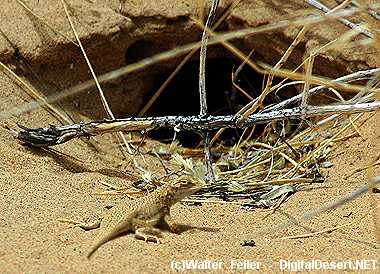
Lizards may seek shelter in cool, moist burrows
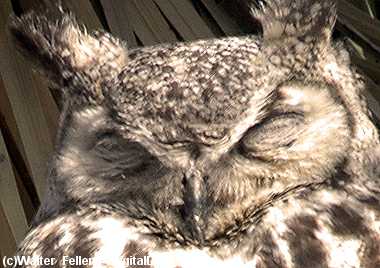
Owls will sleep during the day
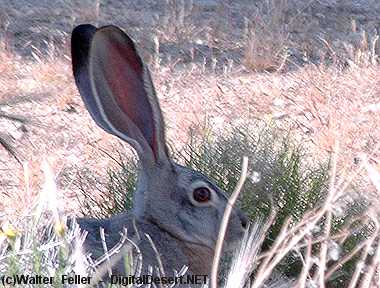
Large ears help to keep the jackrabbit cool
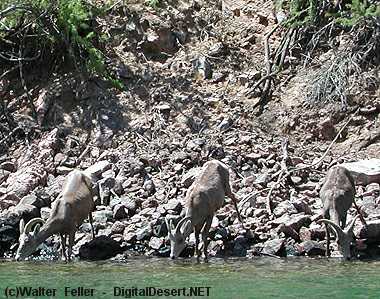
Bighorn sheep are limited by distances to water resources, however will drink enough for several days within a short period of time
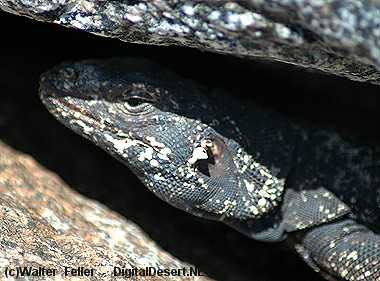
Chuckwalla rarely, if ever drink free-standing water and recieve moisture from the wildflower blossoms they eat